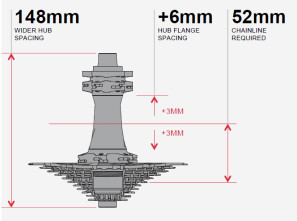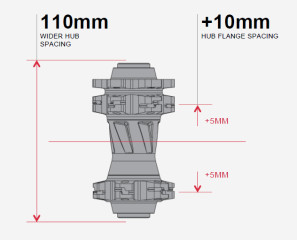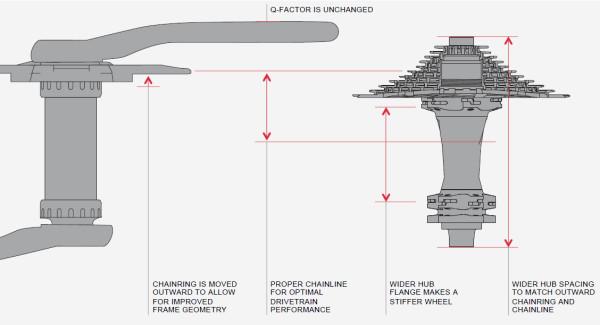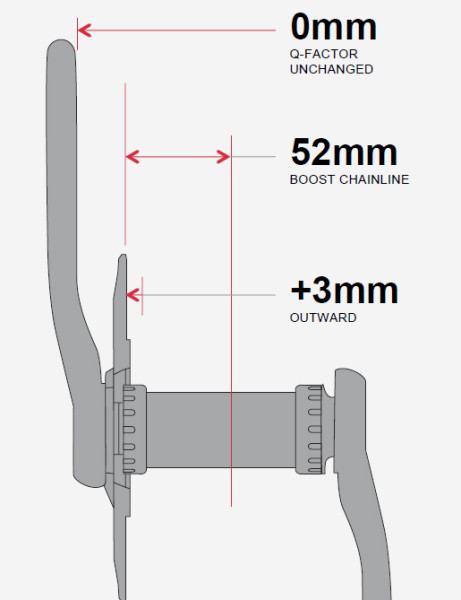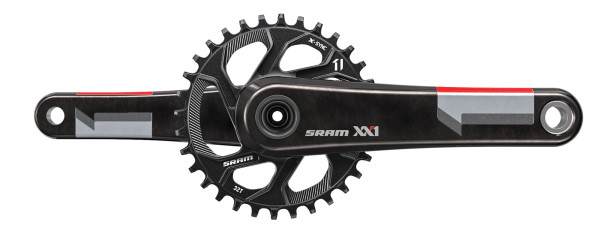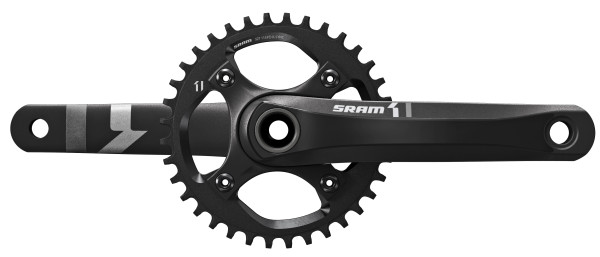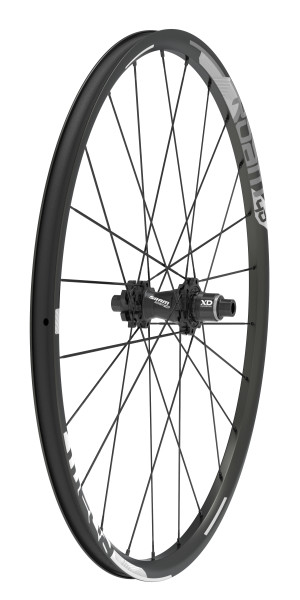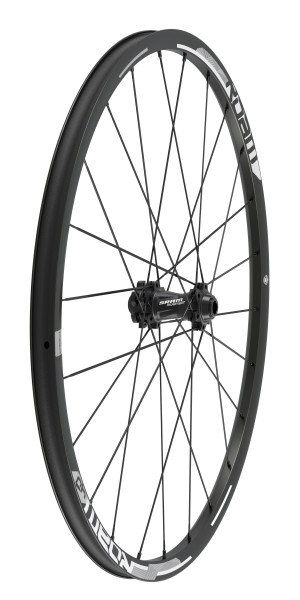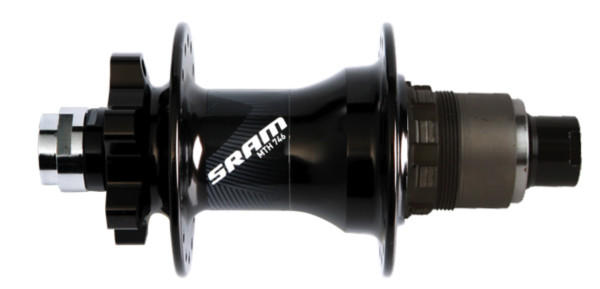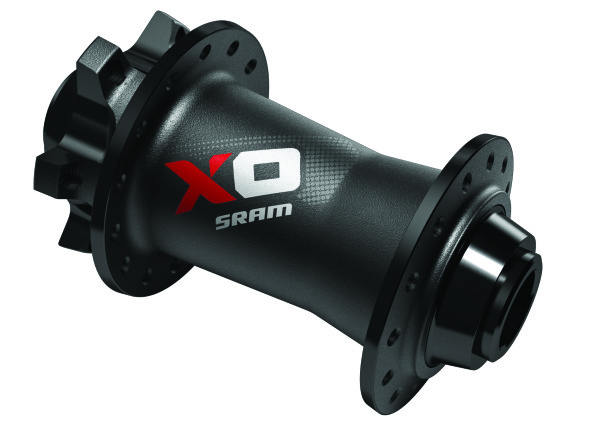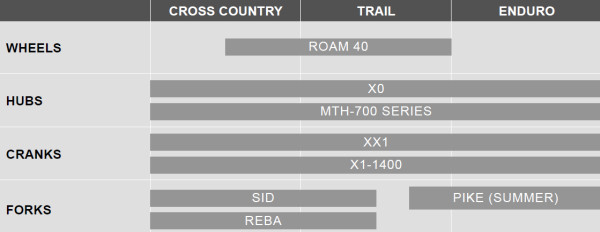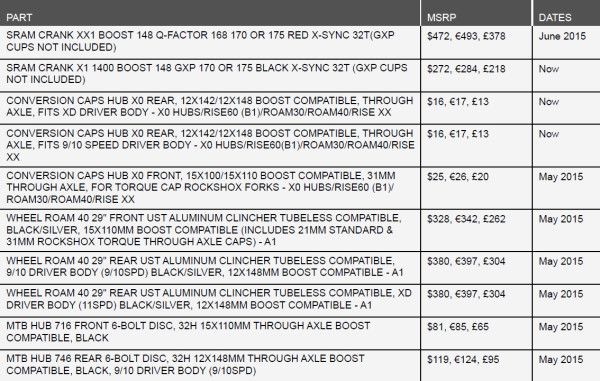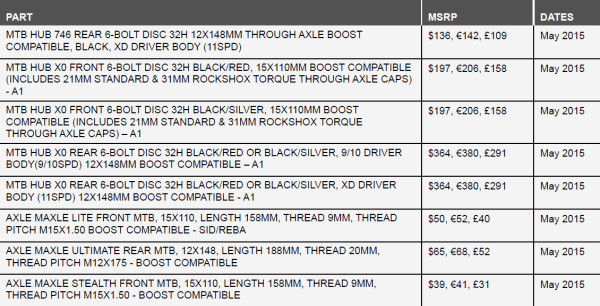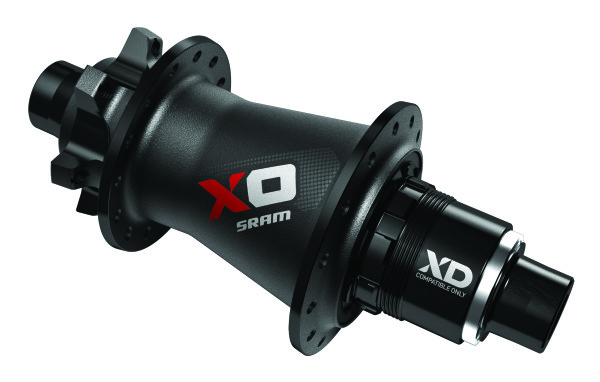
We first heard of Boost 148 when Trek unveiled the new Remedy 29. Sort of a soft launch, not much was really said about the new specification other than the rear hub was 148mm wide and it involved wider flange spacing for improved rear wheel stiffness. Now with the latest release from SRAM, Boost goes from a specification on a single bike to what they are calling an open platform that will offer performance benefits not just for the rear wheel, but for the frame, fork, and front wheel as well.
What is an extra 6 mm for the rear and 10mm for the front of the bike really going to do for you in the long run? SRAM claims that built with the same spokes, nipples, and rim, a 29″ wheel built with the Boost spec will offer the same level of stiffness found on a 27.5″ wheel built to the previous 142mm hub. The same can be said for the front wheel with a 29″ wheel laced to a new 15×110 mm hub carrying the same stiffness of a 26″ wheel built with a 15×100 mm hub. The wider specifications will also allow for improved tire clearance allowing for that coming wave of 27.5+…
Rather than just a new size for rear hubs, SRAM refers to the entire package of rear hub, crank, and front hub and fork as Boost. By moving the flange spacing and hub spacing outward on the rear hub the Boost 148 design makes for a stiffer wheel, but that comes with a change in chainline. In order to keep the chainline in check SRAM will be offering Boost specific cranksets that add 3mm to the chainline to bump it up to 52mm. According to SRAM, Boost 148 rear hubs must be used with Boost cranks, and vice versa. While the chainline has been boosted, the Q-factor remains the same since the chainring is the only part of the crank that gets relocated.
SRAM points out that the move to 1x drivetrains with XX1 was always a part of their vision to add more space around the crankset for frame designers. Moving the chainline out from the frame’s center is the next step and should allow for bigger tire clearances, wider suspension pivots, and even shorter chainstays not to mention the ability to run bigger chainrings in certain cases.
Boost cranksets will initially be offered in the SRAM XX1 and X1 1400 models with a 24mm spindle only. Both cranksets utilize SRAM’s X-Sync tooth profile with direct mount rings for XX1 and 4 bolt 104 BCD for the X1.
XX1 CRANK
- X-SYNC™ tooth profile provides maximum chain control
- Carbon arms with forged aluminum spider
- CNC- X-SYNC™ Direct Mount ring
- BOOST option
- Wide/narrow Q-factor cranks for BB30 and GXP
X1 1400 CRANK
- X-SYNC™ tooth profile provides maximum chain control
- Hollow forged aluminum arms with forged aluminum spider
- Chain ring guard option
- BOOST option
- CNC – X-SYNC™ machined ring
Boost Wheels and Hubs
As for the rear wheels and hubs, Boost technology will be available with the SRAM ROAM 40 wheels, and the X0 and new MTH 700 hubs. The Taper Core aluminum ROAM 40 wheels are UST Tubeless and come with the SRAM Double Time hubs that are convertible to any axle type with XD or 10 speed driver bodies. Boost compatible ROAM 40 wheels (12×148 and 15×110) will only be available in 27.5 and 29″ models which makes sense as we don’t expect to see any 26″ bikes with the new specification any time soon.
SRAM X0 hubs will be offered in 32 spoke j-bend hubs in 12×148 and 15×110 with XD or the 8/9/10 freehub body. SRAM is also introducing a new affordable hub for thru axle bikes that will be compatible with the latest Boost specifications. Called the MTH 700, the 32 hole hubs will come in around 170g for the front and 410g for the rear, and be available with XD or 8/9/10 freehubs.
ROAM 40 WHEEL
- Lightweight aluminum rim with asymmetrical TAPER CORE™ profile—with a welded joint
- UST tubeless
- User-friendly SOLO SPOKE™ technology
- Durable, precision-machined SPEEDBALL™ bearings
- Strong, fast engagement with DOUBLE TIME™ hubs
- Available in all three wheel sizes
- BOOST 12×148 and 15×110 options available for 27.5″ and 29″
- Convertible to any axle type
- Available in XD™ or 10-speed driver body
- Color: Black/Silver
X0 HUB
- Tapered aluminum axle is stronger without added weight
- All axles types
- 32 spoke holes
- BOOST 12×148 and 15×110 options
- Sand-blasted black with red label
- Glossy black with silver accents
- 11-speed XD™ Driver Body
- 10-, 9- and 8-speed driver body
- Weight: 130g (front), 250g (rear)
700 SERIES HUB
- 32 spoke holes
- BOOST 12×148 and 15×110 options
- Black
- 11-speed XD™ Driver Body
- 10-, 9- and 8-speed driver body
- Weight: 170-410g
All of the mentioned hubs and wheels will include a Boost front hub that will be compatible with the updated 15x110mm axle size. We’ve already gone into detail on the new size here, but the thinking is the same as for the rear with the wider hub offering improved stiffness and additional tire clearance. As an update for MY16, RockShox will be updating some of their most popular suspension forks like the SID, REBA, and PIKE to allow for the wider hub spacing. SRAM also points out that all 29″ Boost compatible suspension forks will fit 27.5″ x 3.0 tires.
Pricing and Availability:
The chart above illustrates which SRAM and RockShox products will be compatible with Boost and their intended use.
